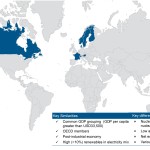The World Energy Council’s (WEC) global ranking of country energy sustainability performance has revealed that most of the over 90 countries assessed are still far from achieving fully sustainable energy systems.
The 2012 Energy Sustainability Index, published within the WEC’s 2012 World Energy Trilemma report, “Time to get real – the case for sustainable energy policy”, finds that most countries still have not managed to balance the energy trilemma. The WEC argues that countries must balance the trade-offs between the three challenges of the trilemma: energy security, social equity, and environmental impact mitigation, if they are to provide sustainable energy systems.
The Index reveals that:
-
Environmental impact mitigation remains a universal problem;
-
Providing high-quality and affordable energy access remains a significant challenge for developing and emerging economies; and
-
Countries at various stages of development struggle with energy security.
Joan MacNaughton, Executive Chair of the World Energy Trilemma report, says: “Much still needs to be done to make our energy systems sustainable, but there is good news. As our Energy Sustainability Index shows, countries that use a larger share of low-carbon energy such as renewables and nuclear as part of a diversified energy mix tend to perform better. While these top performers also tend to be richer countries, some less affluent ones do also outperform their economic peers. What distinguishes all these countries from the others is that they have more effective and coherent policies.”
The top 10 performing countries in the WEC index are Sweden, Switzerland, Canada, Norway, Finland, New Zealand, Denmark, Japan, France and Austria, respectively. However, even top performers face challenges, and as countries pass through the stages of development they struggle in specific areas.
Mark Robson, Partner of Oliver Wyman, the global consulting firm Oliver Wyman which compiled the Index with the WEC, says: “Providing sustainable energy is the responsibility of both government and industry. As governments weigh up their countries’ priorities, businesses must be assured that the economics of their investments won’t be destroyed by changes in energy policy. This policy risk is a key factor holding back energy investments today. Therefore government and industry must engage in active dialogue about structuring policies that remain stable over time and are joined up with other policies.”
For the first time this year, the Energy Sustainability Index comes with a set of country and regional performance profiles. Now in its third annual edition, the Index captures and aggregates country-level data to outline the relative energy performances and contextual attributes of the WEC’s member countries. Its global findings show:
-
Environmental impact mitigation remains a universal problem. In general, as countries’ GDP per capita increases they also rise up in the Index’s measures of environmental impact mitigation. Countries are likely to successfully mitigate CO2 emissions and to improve air and water quality if they low-carbon energy resources.
-
For developing and many emerging economies, providing high-quality and affordable energy access remains a significant challenge. The main challenge identified is that scarce financial resources on the demand and supply sides limit the functioning of markets and the ability to attract energy investments.
-
Countries at various stages of development struggle with energy security. Developing and emerging economies primarily struggle with energy security due to their strong consumption growth. Some developed countries, on the other hand, struggle to expand domestic production of energy to meet growing consumption. However, countries with higher GDP per capita tend to have a more secure energy supply with the top 10 performers in the Index all ranking high in energy security, enabled by political will, strong institutional frameworks, and the necessary finances.






